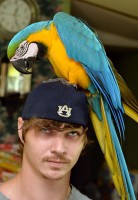A Saks family found itself with a feathery visitor native to South America on Saturday when a blue-and-gold macaw turned up in their neighborhood.
Bong Santos said he was cutting his grass Saturday afternoon when he heard strange squawking noises.
“I just ignored it at first,” he said, thinking it was just a bird flying by overhead. But over an hour later, Santos still heard the same distinctive squawking.
“I looked around, and I see this bird,” he said, referring to the brilliant blue and gold macaw in the cage in his living room Wednesday. “I was shocked.”
It took Santos almost two hours to catch the bird Saturday, which was flying around Timike Drive in Saks, where his family lives.
“If we didn’t catch it and it flew away, what would happen then?” asked Santos’ mother, Felisa Hernandez.
Hernandez’s daughter Crystal said that her children, Xavier and Jasmine, are already attached to the bird: They’ve named it Polly.
“Whenever Jasmine comes in from school, the first thing she says is ‘I’m home, Polly!’ Then she wants to feed it,” Crystal said.
Tom Nelson, a veterinarian with Animal Medical Center in Anniston, said blue and gold macaws eat fruits and vegetables and can live to be about 50 years old. They aren’t that uncommon among exotic pet owners in the area, either.
“We actually get quite a few in the area that we see come in,” he said. “We get most birds in a 50-mile radius because we’re one of the few practices that treat those types.”
Nelson said blue-and-gold macaws are more common than other varieties of the bird because they’re “more economical to purchase.”
A blue-and-gold macaw, he said, could cost between $1,500 and $2,000. A Hyacinth macaw, a breed that grows much larger, could cost between $12,000 and $15,000.
Nelson said he gives anyone who gets non-traditional or exotic pets, like a macaw, the same speech.
“The most important thing is to make sure they’re eating right, and that they’re in the correct caging,” he said.
For blue-and-gold macaws, whose natural diet consists mostly of tropical fruits, a variety of fruits and whole-grain pellets are the best food. Seeds and other typical bird food mixes are not, Nelson said.
Depending on where they came from or were bred, Nelson said birds are normally identified by numbered bands placed around the leg.
“If it’s not banded, marked or tattooed, it would be difficult to say one way or the other” who the bird belongs to, he said.
Phyllis Nelson, who works at Flock Together Bird Rescue in Windsor, S.C., said that owners often abandon their birds because of the cost of caring for them.
“People just can’t take care of them anymore. They get too expensive and people just let them go,” she said. It costs between $40 and $80 a month to care for one blue-and-gold macaw.
Flock Together is a non-profit, no-kill bird adoption agency, and is home to about 100 birds, Nelson said.
Staff writer Zach Tyler: 256-235-3564. On Twitter @ZTyler_Star.


